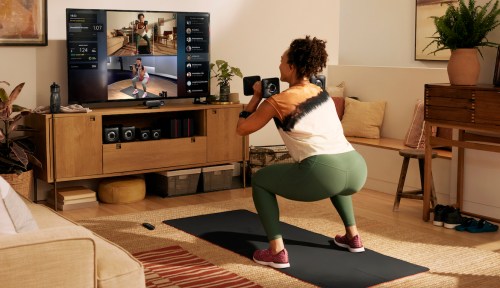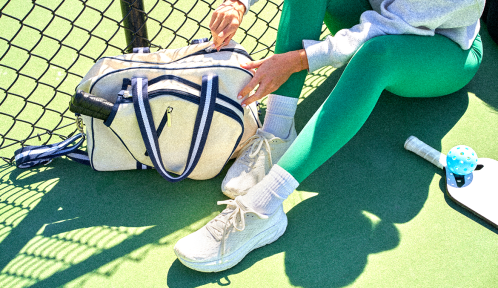Our editors independently select these products. Making a purchase through our links may earn Well+Good a commission
You’re nearing the end of a set, your muscles are shaking, and the instructor starts her countdown: “Five, four, three…” Do you push through to the bitter end, or do you figure you made it far enough and reach for your water bottle?
Experts in This Article
fitness expert and Peloton instructor
Especially when working out at home, it’s all too tempting to take the easier route. But Peloton’s new connected strength-training product is designed to convince you otherwise.
Although the company has had an app for strength-training, bootcamp, and yoga classes for the past few years, it’s remained mostly known for its cardio offerings: Despite heavy competition, Peloton remains the gold standard for living room cycling sessions, and has a mega fan following for its Tread. Now, the brand is making a move to become a strength-training destination with the launch of Peloton Guide.
Using smart camera technology, the Guide tracks your reps as you follow instructors through live and on-demand strength classes. To encourage you to keep you sweating, you earn badges for completing exercises, and can track your progress over time.
With prices starting at $295 (plus an introductory rate of $24 per month if you don’t already have a membership), it’s Peloton’s most accessibly-priced connected device yet. And at just a few inches long, it’s by far the easiest to fit into your home. But are the benefits worth it over a straightforward membership to the app?
I took the Guide for a test spin with a couple of friends to try it out and see.
Here’s what it’s like to work out with Peloton Guide
The Guide is small enough that it can sit right below, or even on top of your TV. (Yes, there’s a slider to cover the camera when you’re not using it, and you can also turn off the voice control to make sure nothing fishy goes on after your workout.) The setup is fairly intuitive, though it did take about half an hour to run through all the updates and personalized settings before we could get started.

It also took a little trial and error to get the camera to track my movements even when both friends stood off to the side (though you can add multiple users, it can only track one at a time). But once it connected correctly, the camera would automatically adjust to zoom in and follow me as I transitioned, for instance, from standing to kneeling, which conveniently kept me from having to worry much about staying in frame.
We chose a 10-minute core class, then a 20-minute full-body strength session using dumbbells. While scrolling through the options, an avatar in different shades of blue highlights which muscle groups you’ll be using. You can also peek through the “class plan” listing every single movement you’ll be doing, and, if you want, get a full demo of each. It was helpful to know exactly what to expect (and avoid anything we weren’t in the mood for).
Once we started, the Guide’s movement tracker followed my reps even when I made modifications, and gave me credit as I completed them all. Seeing the little Peloton logo in the corner gradually fill up as I continued to through a set meant I had to push through to the end if I wanted to get that rush of seeing the whole thing light up.
The program allows you to choose how big you see yourself on screen and also hide any of the stats (like how much longer you have in a set, what move is next) that you don’t want to see. One I wish we’d turned off? The calorie burn. Not only do I not love focusing on calories when working out, the number seemed completely arbitrary; I hadn’t input my height or weight, or the dumbbells I was using.
In October 2022, Peloton responded to popular request and also added a rep tracking feature, which records what size weights you’re using, charts your progress with them from class-to-class, and offers videos specifically designed to challenge this part of your fitness, like AMRAP (as many reps as possible) workouts.
After each class, you get badges for your achievements (“Movement Tracker Gold,” and “First Strength Workout”) and credits for the exercises you fully completed. During the core workout, the Guide correctly tracked whenever I was or wasn’t moving—yes, I did take a break, ahem, “just to test it out.” But in the next class it said I’d skipped some lunges and squats even though I’d never actually stopped. Maybe I didn’t do them facing the right direction for the camera to capture?
To make sure you’re following a well-rounded regimen, the Guide will show you which muscle groups you’ve worked out in the last week and the last month, and also recommend which types of classes to try next for full-body fitness.

Why use the Peloton Guide rather than just taking classes?
While Peloton is offering programming specific to the Guide—including certain live classes and a four-week bootcamp series taught by trainers Jess Sims and Selena Samuela—the vast majority of the workouts are those available on the regular all-access membership. So why upgrade?
“A huge barrier to entry is knowledge,” points out Sims. “Beginners always say, ‘I don’t want to get hurt,’ and ‘I don’t know where to start.’ ” If you’re new to strength training, the Guide’s movement library allows you to break down proper form on your own timeline. “If you wish the instructor had demonstrated longer, you can spend time before or after the workout learning how to do the movements—without having to stop the workout itself,” says Sims.
The camera also offers you a chance to self-check. By sharing your image on screen, you can watch how your form compares to the instructor’s, similar to how you would be able to see yourself in a mirror at the gym.
Sims also points out the accountability factor: “You don’t want to stop five seconds early, because you want to get the full credit!” And by showing exactly which body parts you’ve been working, the body activity monitor motivates you to not skip leg day. These little “gamifications” are the kind of thing that could keep you coming back to rack up credits and badges.
As much as the Guide is advertised as being for anyone, however, these features very much seem geared for a particular population: Those just starting out, or who want a kick-in-the-butt to work out. Veteran fitness fiends who mostly know what they’re doing with a pair of dumbbells don’t typically need this much breakdown or external motivation. For newbies, though, the Guide’s benefits could be the difference between starting to train only to get injured and give up, and actually sticking with a strength routine long enough to see real results.
Sign up for the Well+Good SHOP Newsletter
Get exclusive deals on wellness, beauty, fitness, and food products that have been hand-picked by our editors.
Got it, you've been added to our email list.










